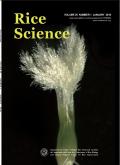Disruption of Energy Metabolism and Reactive Oxygen Species Homeostasis in Honglian Type-Cytoplasmic Male Sterility (HL-CMS) Rice Pollen
IF 5.6
2区 农林科学
Q1 AGRONOMY
引用次数: 0
Abstract
Honglian type-cytoplasmic male sterility (HL-CMS) is caused by the inter-communication between the nucleus and mitochondria. However, the mechanisms by which sterility genes regulate metabolic alterations and changes in mitochondrial morphology in the pollen of HL-CMS remain unclear. In this study, we compared the morphological differences between the pollen of the male sterile line YA and the near-isogenic line NIL-Rf6 using hematoxylin-eosin staining and 4ʹ,6-diamidino-2-phenylindole (DAPI) staining. HL-CMS is characterized by gametophytic sterility, where the aborted pollen grains are empty, and the tapetal layer remains intact. Transmission electron microscopy was employed to observe mitochondrial morphological changes at the microspore stage, revealing significant mitochondrial alterations, characterized by the formation of 'large spherical mitochondria', occurred at the binucleate stage in the YA line. Additionally, metabolomics analysis revealed decreased levels of metabolites associated with the carbohydrate and flavonoid pathways. Notably, the decrease in flavonoids was found to contribute to an elevation in reactive oxygen species (ROS) levels. Therefore, we propose a model in which rice fertility is modulated by the levels of pollen carbohydrates and flavonoid metabolites, with impaired mitochondrial energy production and reduced flavonoid biosynthesis as the main causes of ROS accumulation and pollen abortion in rice.
红莲型细胞质雄性不育(HL-CMS)水稻花粉能量代谢和活性氧稳态的破坏
红莲型细胞质雄性不育(HL-CMS)是由细胞核和线粒体之间的相互交流引起的。然而,不育基因调控HL-CMS花粉代谢改变和线粒体形态变化的机制尚不清楚。本研究采用苏木精-伊红染色法和4′,6-二氨基-2-苯基吲哚(DAPI)染色法比较了雄性不育系YA与近等基因系NIL-Rf6花粉的形态差异。HL-CMS的特点是配子体不育,败育的花粉粒是空的,绒毡层保持完整。透射电镜观察了小孢子期线粒体形态的变化,发现在YA系的双核期线粒体发生了明显的变化,其特征是形成了“大球形线粒体”。此外,代谢组学分析显示,与碳水化合物和类黄酮途径相关的代谢物水平下降。值得注意的是,黄酮类化合物的减少有助于活性氧(ROS)水平的升高。因此,我们提出了一个水稻育性受花粉碳水化合物和类黄酮代谢物水平调节的模型,线粒体能量产生受损和类黄酮生物合成减少是水稻ROS积累和花粉败育的主要原因。
本文章由计算机程序翻译,如有差异,请以英文原文为准。
求助全文
约1分钟内获得全文
求助全文
来源期刊

Rice Science
Agricultural and Biological Sciences-Agronomy and Crop Science
CiteScore
8.90
自引率
6.20%
发文量
55
审稿时长
40 weeks
期刊介绍:
Rice Science is an international research journal sponsored by China National Rice Research Institute. It publishes original research papers, review articles, as well as short communications on all aspects of rice sciences in English language. Some of the topics that may be included in each issue are: breeding and genetics, biotechnology, germplasm resources, crop management, pest management, physiology, soil and fertilizer management, ecology, cereal chemistry and post-harvest processing.
 求助内容:
求助内容: 应助结果提醒方式:
应助结果提醒方式:


